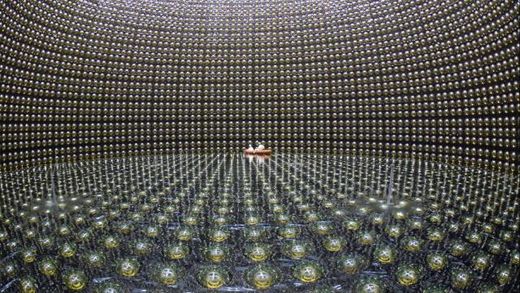The T2K project in Japan is one of the world's foremost neutrino detectors, and it appears to be on the verge of a crucial discovery. However, these experiments have been on hold since the earthquake in March, so the results have to remain provisional until the work can start back up again.
Specifically, it seems to have found evidence that neutrinos can spontaneously change their "flavor", so that a specific particle can be measured as one type of neutrino and then again later as a different type. Physicists have seen evidence of neutrino oscillation in previous experiments, but this would be the first hard evidence for oscillation from muon neutrinos, which are the middle-sized neutrinos, to electron neutrinos, which are the lightest and most common flavor.
Before work had to be suspended, the T2K project had picked up on an excess of electron neutrinos emanating from a beam of what should have been almost exclusively muon neutrinos, which suggests oscillation from one to the other was taking place. The results aren't quite conclusive enough to claim a discovery - and we've seen recently how difficult finding clinching proof can be - but it's definitely a strong sign of this new form of oscillation.
Imperial College London Professor David Wark, who heads up the British arm of the T2K project, explains what this could all mean:
"It's a step on the road. We want to address this asymmetry, but first we have to show that the different 'flavours' of neutrinos can spontaneously change into each other - something we call 'neutrino oscillation'. So far, our experiments have been very positive. The oscillations of neutrinos are governed by three angles which you can think of like pitch, yaw and roll for an aeroplane. In the past, we've measured pitch and yaw, but we had no sign that roll was different from zero. If these turn out to be real events, then we'll have shown that roll is not equal to zero."In this analogy, "roll" refers to theta-one-three. Although this may all seem a bit abstract, here's the upshot: if theta-one-three is equal to anything other than zero - and that's what this result certainly suggests - then it means that the oscillations of neutrinos may be fundamentally different from those of antineutrinos. This slight difference in oscillation could have been enough for neutrinos to become more common than antineutrinos in the early universe, and thus help matter become dominant over antimatter.
Professor Wark continues:
"There have to be some laws of physics we don't know about because all the laws we do know about cannot produce any significant excess of matter over antimatter. There are a number of places these laws could be hiding, and one of the most promising places to look is neutrinos. But the first step has to be to prove that theta-one-three is not equal to zero. If it were then neutrinos and antineutrinos would have to oscillate the same way - there just aren't enough degrees of freedom to allow them to be different."




Worry about the Fukushima neutron FALLOUT, INSTEAD!